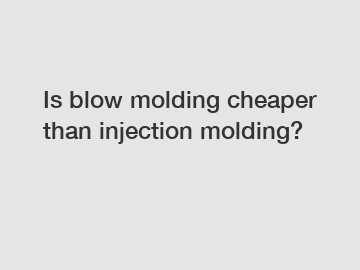Is blow molding cheaper than injection molding?
Is Blow Molding Cheaper Than Injection Molding?
When it comes to plastic manufacturing processes, two commonly used methods are blow molding and injection molding. These techniques are widely utilized in various industries to produce a wide range of plastic products. However, one common question often arises: which method is more cost-effective? In this article, we will dive into the details of blow molding and injection molding, analyzing their cost factors and comparing their overall affordability.
Blow Molding: Overview and Cost Factors.

Blow molding is a manufacturing process used to create hollow plastic products. It involves heating a thermoplastic material and then using compressed air to blow it into a mold cavity, thereby forming the desired shape. This technique is most commonly used to produce containers, bottles, and other similar products.
When considering the cost factors of blow molding, several variables come into play:
1. Mold Costs: The initial investment in creating a blow mold can be quite high compared to other molding methods. The cost of designing and fabricating the mold is a significant factor that needs to be considered.
2. Material Costs: Another essential aspect is the cost of the material itself. The raw material used in blow molding can vary in price depending on the type, quality, and availability.
3. Labor Costs: Blow molding requires skilled operators to control the machinery and ensure proper production. These labor costs ultimately contribute to the overall expense.
Injection Molding: Overview and Cost Factors.
Injection molding, on the other hand, is a more versatile process that can be used to produce a wider range of products, including components with intricate details. In this method, molten plastic is injected into a mold cavity, cooled, and then solidifies into the desired shape. Injection molding is widely used in industries such as automotive, electronics, and consumer goods.
When discussing the cost factors of injection molding, here are several key considerations:
1. Mold Costs: Similar to blow molding, the cost of creating an injection mold can be significant. The more complex and intricate the design, the higher the cost of fabricating the mold.
2. Material Costs: The choice of material significantly affects the overall costs of injection molding. Different types of thermoplastics or thermosetting polymers have various price ranges, and some may require additional additives, increasing the material costs.
3. Production Efficiency: Injection molding allows for high-volume production at a fast pace, reducing labor costs per unit. However, the cycle time for injection molding may be longer than blow molding, potentially impacting overall production costs.
Comparison and Conclusion.
In terms of cost-effectiveness, both blow molding and injection molding have their advantages and disadvantages. Blow molding can be more cost-effective for large-scale production of simple and hollow plastic products, as it requires a lower initial investment in molds and has lower material costs. On the other hand, injection molding provides better flexibility for complex designs and a wider range of materials, making it a more suitable option for smaller production runs and intricate components.
Ultimately, the decision between blow molding and injection molding should be based on the specific requirements of the product, including design complexity, production volume, and desired materials.
If you have any further questions regarding blow molding or injection molding, please do not hesitate to contact us. Our team of experts is here to assist you in choosing the most cost-effective and suitable manufacturing method for your plastic product needs.
Contact Us.
Contact us to discuss your requirements of turnover box injection mould quantity, pe foam sheet extruder, Automated Single Double Station Blow Molding Machine. Our experienced sales team can help you identify the options that best suit your needs.


